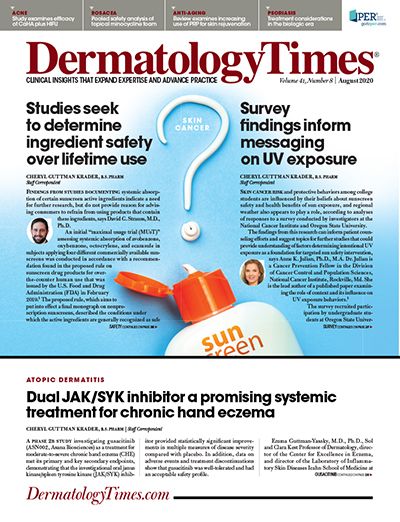- General Dermatology
- Eczema
- Alopecia
- Aesthetics
- Vitiligo
- COVID-19
- Actinic Keratosis
- Precision Medicine and Biologics
- Rare Disease
- Wound Care
- Rosacea
- Psoriasis
- Psoriatic Arthritis
- Atopic Dermatitis
- Melasma
- NP and PA
- Skin Cancer
- Hidradenitis Suppurativa
- Drug Watch
- Pigmentary Disorders
- Acne
- Pediatric Dermatology
- Practice Management
Skin microbiome altered in some rosacea subtypes
A recent study aimed to elucidate the association between variations in the skin’s microbiome and the development of rosacea symptoms.
An imbalance of the microbiome may play a role in the pathogenesis of some subtypes of rosacea, a recent study finds.1 While Cutibacterium appears to play a protective role in maintaining healthy skin, Staphylococcus and Streptococcus appear to be factors in disease pathogenesis, researchers write.
Yan Wu, M.D., professor of the department of dermatology, Peking University First Hospital, Peking, China, and fellow colleagues, presented a poster during the AAD VMX Virtual Meeting Experience 2020. Their study aimed to characterize the different microorganisms found in the skin’s microbiome of rosacea patients compared to those of healthy controls in the hopes of finding an association between the skin’s varying microorganism counts and the presentation of disease.
The composition of the skin’s microbiome is understood to be crucial for homeostatic skin immune functions, and the current conventional wisdom for the development of rosacea is that the innate immune system cannot appropriately recognize the commensal organisms which live and breed naturally on the skin such as P. acnes, S. epidermidis, as well as demodex folliculorum. The subsequent inflammatory response to these microorganisms by the innate immune system results in the typical spectrum of symptoms seen in rosacea patients.
In their case-control study, Dr. Wu and colleagues sought to characterize the skin bacterial and fungal microbiome in different subtypes of rosacea patients compared with those of healthy individuals. Of the 58 participants enrolled in the study, 21 patients had erythematotelangiectatic rosacea, 15 had papulopustular rosacea, and 22 participants were healthy subjects who served as the control. Researchers extracted DNA from skin samples collected from the cheeks of study participants, and the 16S rRNA V3/V4 genes and internal transcribed spacer one region were sequenced. There were no significant differences in age and gender among the three study cohorts.
Results showed that the alpha diversity index in the patients with papulopustular rosacea was elevated compared to that of healthy controls. In addition, the weighted Unifrac-principal coordinates analysis (Unifrac-PCoA) of bacterial microbiome revealed that the skin samples of erythematotelangiectatic and papulopustular rosacea patients tended to cluster but were separated from those of healthy controls.
“Our study revealed an alteration in the burden of certain pathogenic and protective bacteria in the facial skin microbiome of rosacea patients,” wrote Yan Wu, M.D., and fellow colleagues, in the study poster.
Researchers found that rosacea is specifically associated with an alteration in the relative abundance of specific taxa. Results showed that at the phylum level, Actinobacteria and Firmicutis were the most abundant in the facial skin and compared to controls. Actinobacteria demonstrated an obvious decreasing trend in both erythematotelangiectatic and papulopustular rosacea patients. At the genera level, Cutibacterium was significantly decreased in rosacea patients compared to control subjects. Data also showed an increase in the abundance of staphylococcus in those patients with papulopustular rosacea.
Disclosures:
The authors report no relevant disclosures.
Reference:
1 Wang R, Li R, Wu Y. Skin Microbiome in Patients with Rosacea and Healthy Controls. E-poster presented at AAD VMX Virtual Meeting Experience 2020 June 12 14. https://eposters.aad.org/posters/14339/14339.pdf

